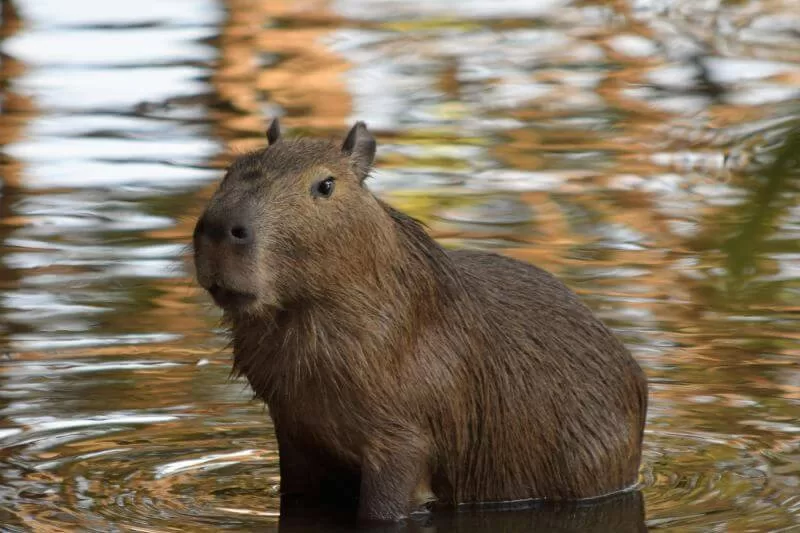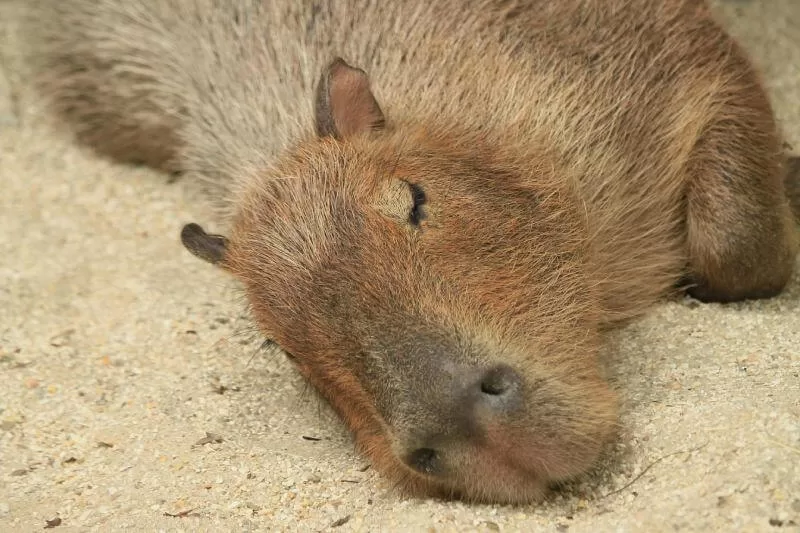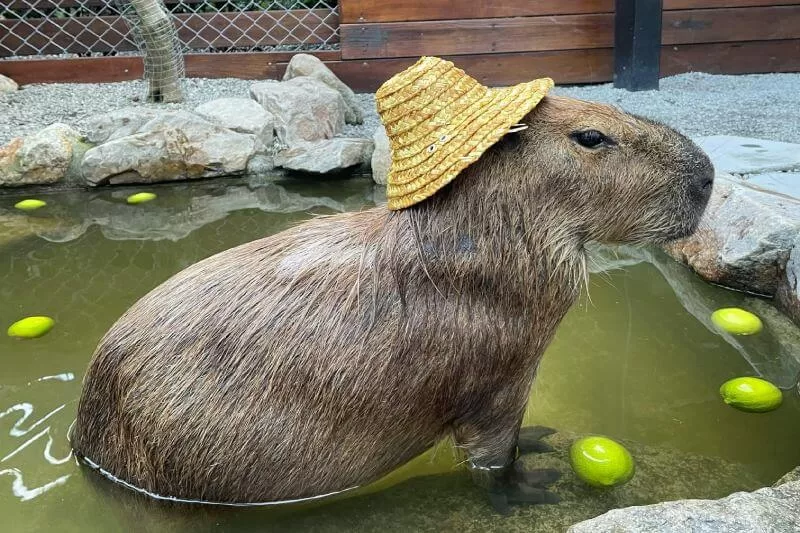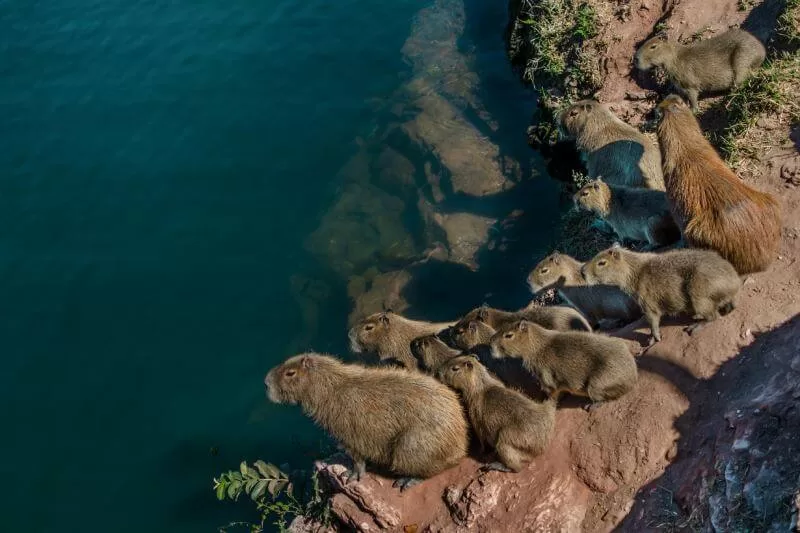Capybaras have taken the internet by storm. Their calm demeanor and friendly faces make them meme favorites. Yet, there’s more to them than viral fame. Here we offer some facts about capybaras.
These creatures inhabit South America’s water-rich regions. They are the largest rodents in the world. Beyond their size, their social habits intrigue many.
This post dives into the world of capybaras. From their natural habitats to surprising behaviors, we cover it all. Prepare to explore beyond the memes. And maybe visit some capybaras on your next trip.
Capybaras captivate many with their serene nature. Known scientifically as Hydrochoerus hydrochaeris, they hold a unique place in the animal kingdom. As the world’s largest rodents, their social behavior offers fascinating insights into their survival strategies.
Native to South America, these gentle giants thrive in its wetlands and rivers. Their adaptability to aquatic environments is noteworthy. This is thanks to their webbed feet, which make them excellent swimmers.
Capybaras can stay submerged for minutes at a time. This ability helps them escape predators. It also allows them to feed on aquatic plants, essential to their diet.

Capybaras live in groups that enhance their survival. These groups can number from 10 to 20 members, sometimes even more. Within these communities, a complex social hierarchy exists.
The group’s structure revolves around a dominant male. This hierarchy helps maintain order and ensures the group’s safety. It also plays a crucial role during the mating season.
Females, too, have their own ranking system within the group. This hierarchy influences their breeding success. It also affects the care of their young, known as pups.
Capybaras have adapted well to their natural habitat. Their barrel-shaped bodies are perfect for life in and out of water. These adaptations make them formidable residents of their domain.
Their diet mainly consists of grass and aquatic plants. Capybaras are herbivores, grazing near water bodies. This diet is crucial for their health and well-being.
Interestingly, capybaras eat their own poop. This odd behavior helps them digest cellulose more efficiently. It ensures they get the maximum nutrients from their food.
Capybaras play a significant role in their ecosystems. As a food source, they support a variety of predators. This includes jaguars, caimans, and large birds of prey.
Their grazing habits also help maintain the health of grasslands. This benefits many other species that share their habitat. Thus, capybaras contribute to the biodiversity of their environments.
In regions like the Manu National Park, capybaras are a common sight. Here, they contribute to the area’s natural beauty and ecological balance. Observing capybaras in the Manu offers a glimpse into their untouched world.
Communication is key to the social dynamics of capybara groups. They use a variety of sounds to express emotions and intentions. These range from purring to signal contentment, to alarm barks when threatened.
Grooming plays a crucial role in their social interactions. It strengthens bonds between group members. It also helps establish social hierarchies.
During the dry season, when resources are scarce, their social structure becomes even more important. It ensures all members have access to food and water. This collective behavior is a testament to their intelligence and adaptability.
Capybaras, known scientifically as Hydrochoerus hydrochaeris, stand out in the animal world. These creatures claim the title of the world’s largest rodents. Their habitats stretch across Central and South America, showcasing their adaptability.
Facts about capybaras highlight their preference for water-rich environments. Rivers, lakes, and swamps are their homes. Here, their unique adaptations come into play, particularly their webbed feet.
These partially webbed feet aid in swimming. Capybaras can remain underwater for several minutes. This skill helps them evade predators and forage for food.
Capybaras thrive in wetlands. Their bodies are for navigate these environments. This makes them excellent swimmers. They go in the water for food, transportation and play.
Their habitats are not random. Capybaras select areas that offer abundant food sources and water. These environments support their herbivore diet, primarily composed of grass and aquatic plants.
During the dry season, capybaras may travel in search of water. Their social behavior helps them locate resources. Living in groups ensures their survival.

Capybaras play a vital role in their ecosystems. They are a food source for various predators. This includes large cats, birds, and reptiles.
Their grazing habits impact vegetation. This can influence the overall health of their habitats. By consuming plant life, they help maintain a balance in their ecosystems.
Capybaras also contribute to soil fertilization. This occurs through their unique habit of eating their own poop. It’s an essential part of their digestive process.
Water is central to capybara life. It provides them with safety, food, and a place to cool off. Their bodies are well-equipped for aquatic living, from their webbed feet to their water-repellent fur.
Manu National Park is a prime example of capybara habitat. Here, capybaras find the perfect conditions to thrive. The park’s rivers and marshes offer ample food and protection.
Observing capybaras in the Manu reveals their dependence on water. It’s where they spend a significant portion of their day. Whether foraging, socializing, or escaping predators, water is their sanctuary.
Capybaras have evolved to master their aquatic habitats. Their eyes, ears, and nostrils are on the top of their heads. This allows them to breathe and see while mostly submerged.
Their dense, water-repellent fur provides insulation. This keeps them warm in water and dry on land. Such adaptations ensure their comfort in various environments.
The capybara’s ability to regulate its body temperature is fascinating. Water plays a crucial role in this process. It allows them to stay cool (and they are cool) in the heat.
The conservation of capybara habitats is crucial. It ensures the survival of these gentle giants and maintains biodiversity. Human activities, habitat destruction for urbanization, agriculture and mining , pose significant threats.
Protecting areas like Manu National Park is vital. These sanctuaries offer capybaras the environment they need to flourish. They also allow us to study and appreciate these animals in their natural settings.
Understanding facts about capybaras encourages conservation efforts. It highlights the importance of water in their lives. It also underscores the need to preserve the ecosystems they inhabit.
Capybaras, known as Hydrochoerus hydrochaeris, are much more than internet sensations. These creatures are vital to their ecosystems. Recognized as the world’s largest rodents, their unique traits and behaviors play a crucial role in nature.
Native to South America, capybaras inhabit various water-rich environments. These environments range from rivers to marshes. Their presence in these habitats is no coincidence. It is a result of millions of years of adaptation.
Facts about capybaras often highlight their social nature. They live in groups, which helps them survive. This social structure is not just for protection. It also aids in the management of resources and breeding.

Capybaras are herbivores, feeding on aquatic plants and grasses. This diet positions them as a keystone species in their habitats. Their feeding habits can influence the composition of vegetation in significant ways.
By grazing, capybaras help maintain open areas in forests and wetlands. This prevents overgrowth and supports biodiversity. Such activities ensure that a variety of species can thrive.
In the dry season, capybaras’ search for water leads them to create pathways. These paths are used by other animals. Thus, capybaras indirectly contribute to the well-being of other species.
The relationship between capybaras and water is profound. Their partially webbed feet and hydrodynamic bodies make them excellent swimmers. These adaptations allow them to exploit aquatic environments effectively.
Capybaras spend a considerable amount of time in water. This behavior is not just for feeding or escaping predators. It also helps them regulate their body temperature.
Water bodies are essential for capybaras during the breeding season. They provide a safe environment for their young. This highlights the importance of preserving aquatic habitats for their survival.
Manu National Park, a biodiversity hotspot, is home to many capybaras. Here, their role in the ecosystem is evident. The park offers an ideal setting to observe capybaras in their natural habitat.
Manu’s capybaras contribute to the park’s ecological balance. By feeding on plant material, they help control vegetation growth. This activity supports the health of the aquatic and terrestrial environments within the park.
Observing capybaras in the Manu provides insights into their social behavior. It reveals how they interact with their environment and other species. This interaction is crucial for the ecosystem’s health.
Capybaras play a significant role in maintaining biodiversity. Their grazing prevents the dominance of a single plant species. This promotes a variety of plant life, supporting diverse animal populations.
As a food source, capybaras support predators like jaguars and caimans. This predation relationship is vital for maintaining the balance within ecosystems. It ensures that no single species dominates, promoting diversity.
Their feces also contribute to the nutrient cycle. This enriches the soil, promoting plant growth. Such contributions are essential for the health of ecosystems.
The conservation of capybara habitats is crucial for ecosystem health. Human activities, including agriculture and urbanization, threaten these environments. Protecting wetlands and forests ensures capybaras and countless other species can flourish.
Efforts to preserve areas like Manu National Park are vital. They serve as sanctuaries for capybaras and other wildlife. Conservation initiatives help safeguard these ecosystems for future generations.
Understanding facts about capybaras and their role in nature is the first step. It leads to greater appreciation and efforts to protect their habitats. This, in turn, supports global biodiversity.

If you got any questions, please do not hesitate to send us a message. We reply within 24 hours!
+51 900 394 399
info@biomanuexpeditions.com
reservas@biomanuexpeditions.com
